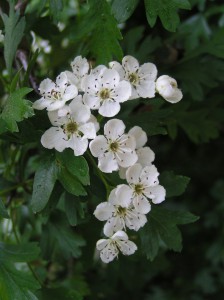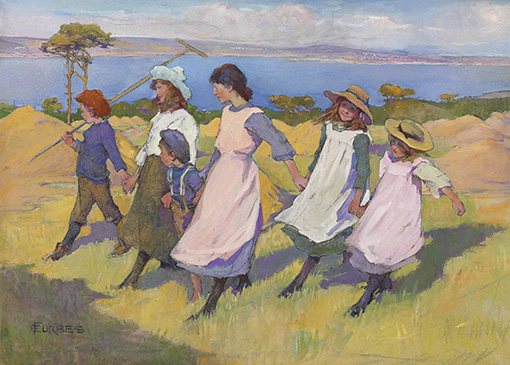Lawrence Silverman sent us this email about the song, “Nuts in May” with the note, “I grew up (a long time ago) in the depths of rural England when many old customs now forgotten were still observed. I don’t like to think of them being altogether forgotten. I’d be delighted to have this posted on your blog…”
About the children’s song, “Here we come gathering nuts in May” (lyrics below), it tells of things long forgotten that were associated with May Day, There are, of course, no nuts to gather in May. They come in the autumn.
I believe the original was not nuts but knots and referred to the knots (bunches) of the mayflower tree (aka hawthorn) that are out at that time when it starts to get warm enough to put aside winter clothes. The mayflower is a symbol of spring and was gathered by young people in the woods on May Eve to make posies —knots of May—to give to the people in their village to commemorate the coming of new life, but particularly a member of the opposite sex they hoped to win as a bride or groom.
Like many May Day customs, which were originally fertility rites, it often got a bit out of hand. Some of the young folk would not come home till morning and not a few weddings would have to be solemnized in the following months. They were known as “greenwood marriages” having been consummated in advance in the woods when the new growth was still green. This makes the original meaning of the song pretty clear.
Here We Go Gathering Nuts in May Lyrics
Nuts in May, nuts in May,
Here we go gathering nuts in May,
On a cold and frosty morning.
Who will you have for nuts in May,
Nuts in May, nuts in May,
Who will you have for nuts in May,
On a cold and frosty morning.
We’ll have [name] for nuts in May,
Nuts in May, nuts in May,
We’ll have [name] for nuts in May,
On a cold and frosty morning.
Who will you have to take her away,
Take her away, take her away,
Who will you have to take her away,
On a cold and frosty morning.
We’ll have [name] to take her away,
Take her away, take her away,
We’ll have [name] to take her away,
On a cold and frosty morning.
Many thanks to Lawrence Silverman for sharing this with us!
-Mama Lisa
Photo: Wikipedia, cc by-sa 3.0.
Painting of Children: Elizabeth Forbes: Here we are gathering nuts in May
This article was posted on Monday, May 22nd, 2017 at 8:23 pm and is filed under Countries & Cultures, England, English, Folk Songs, Holidays Around the World, Languages, Mama Lisa, May Day. You can follow any responses to this entry through the RSS 2.0 feed. You can skip to the end and leave a response. Pinging is currently not allowed.
9 Responses to “About the Song “Here We Come Gathering Nuts in May” and May Day”
Leave a Reply



























July 13th, 2017 at 4:39 pm
Newell’s Games and Songs of American Children has a number of versions, as well as history. His Appendix includes his sources in France, Canada, Belgium, Sweden, Denmark, Italy, Spain, etc. He has the music to a number of rhymes I didn’t know were sung, as well as directions to games and dances — the dear man! Be sure and go to Google Books if you want to download. Ditto for JAFL (Journal of American Folklore). For francophones, Madame de Chabreul’s Jeux et Exercises des Jeunes Filles (1860) at Gallica has loads of songs, info plus musical notation.
June 3rd, 2018 at 5:59 pm
I have just picked a small branch of leaves shaped like beech but smaller, with nuts in cases on them. The casings are green and have stiff fibres on them. The whole tree was covered in nuts in May in a field in England.
September 1st, 2019 at 10:52 am
You are incorrect in saying that there are no nuts to gather in May in the UK
Conopodium Majus or the common Pignut can only be gathered in the spring.
The feathery fronds which comprise the above ground leaves are only visible until the plant flowers in late spring when they then die back leaving no trace of the ‘ nut ‘or tuber lying 10-20 cm underground.
We used to gather Pignuts in May when I was a youngster in the 1960’s but he practice has declined since then and is uncommon nowadays, as is so much other rural foraging.
The song may indeed have been as you purport, referring to ‘ knots ‘ of spring flowers. It might however have been about gathering Pignuts at that same time of year, and the word nuts was in fact correct and not a corruption of the word knot.
September 1st, 2019 at 1:54 pm
Thanks for sharing that Chris!
May 3rd, 2021 at 3:50 pm
please tell Lawrence Silverman that I grew up in rural country, in Sherborne, Dorset, when my survivor mother moved there, having married my decorated British soldier father. GSQ.
May 10th, 2022 at 1:04 pm
I was also told that the song referred to collecting pignuts, Conopodium majus, which is a small wild flower with a ‘nut’ growing below ground level. It can be eaten by badgers and humans.
The artist, Elizabeth Adela Forbes, who moved to Cornwall in 1885 painted a picture entitled “Here we are gathering nuts in May” showing a group of children walking in open grassland where it can be found growing naturally.
The RHS website has more details. https://www.rhs.org.uk/plants/4324/conopodium-majus/details?msclkid=22b3481dd06111eca7b9d95bd8688688
May 10th, 2022 at 1:19 pm
Thanks for pointing out the painting Marianne! I added it to the post above. -Mama Lisa
September 8th, 2022 at 6:15 pm
I still don’t understand the ” cold and frosty morning” bit – not many of those in May…
September 9th, 2022 at 12:45 pm
Kathy, I guess it depends on where you live! :)